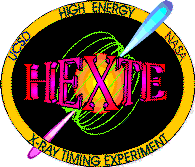

The HEXTE was designed, built and tested at the Center for Astrophysics & Space Sciences, at the University of California, San Diego, where the HEXTE Principal Investigator is Dr. Richard Rothschild.

[CEU] [Shields] [Phoswich Detector Assemblies] [Rocking Mechanism]
Photographs: top view
| Characteristic | Value |
|---|---|
| Energy range | 12-250 keV in 256 channels |
| Energy resolution | dE/E ~ E-0.5; =15% at 60 keV |
| Time sampling | 7.6 µs (maximum) |
| Field-of-view | 2.2° FWZI (FWHM response=1°) |
| Detector material | NaI(Tl), CsI(Na) |
| Net detector area | 2 × 890 cm² |
| Live-time fraction on-source | 60% |
| Count rate from Crab Nebula (12-250 keV) | 250 count/s per cluster |
| Count rate from internal background (12-250 keV) | 90 count/s per cluster |
| Detection sensitivity in 105 s, 3sigma | 10-6 photons/cm2 s keV at 100 keV |
| Source/background dwell time | 16 to 128 s |
| Calibration source | 241Am (lines at 17 and 60 keV) |
| Gain variation | <1% |
| Detector operating temperature | 17-27 °C |
| Weight | 390 kg |
| Operational power | 45 W |
| Allocated telemetry rate | 5000 bit/s (average) |
Back to: the HEXTE virtual tour